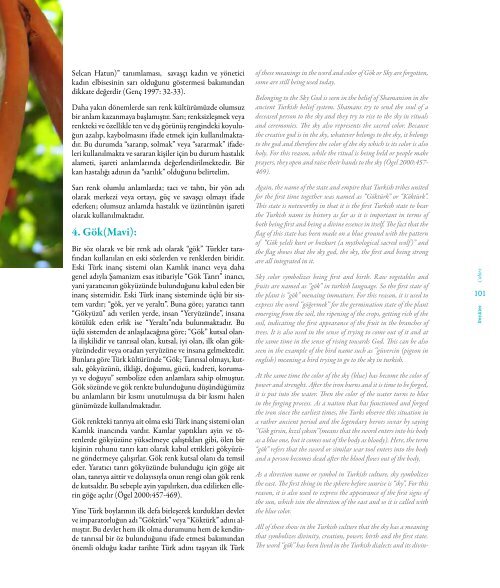You also want an ePaper? Increase the reach of your titles
YUMPU automatically turns print PDFs into web optimized ePapers that Google loves.
Selcan Hatun)” tanımlaması, savaşçı kadın ve yönetici<br />
kadın elbisesinin sarı olduğunu göstermesi bakımından<br />
dikkate değerdir (Genç 1997: 32-33).<br />
Daha yakın dönemlerde sarı renk kültürümüzde olumsuz<br />
bir anlam kazanmaya başlamıştır. Sarı; renksizleşmek veya<br />
renkteki ve özellikle ten ve dış görünüş rengindeki koyuluğun<br />
azalıp, kaybolmasını ifade etmek için kullanılmaktadır.<br />
Bu durumda “sararıp, solmak” veya “sararmak” ifadeleri<br />
kullanılmakta ve sararan kişiler için bu durum hastalık<br />
alameti, işareti anlamlarında değerlendirilmektedir. Bir<br />
kan hastalığı adının da “sarılık” olduğunu belirtelim.<br />
Sarı renk olumlu anlamlarda; tacı ve tahtı, bir yön adı<br />
olarak merkezi veya ortayı, güç ve savaşçı olmayı ifade<br />
ederken; olumsuz anlamda hastalık ve üzüntünün işareti<br />
olarak kullanılmaktadır.<br />
4. Gök(Mavi):<br />
Bir söz olarak ve bir renk adı olarak “gök” Türkler tarafından<br />
kullanılan en eski sözlerden ve renklerden biridir.<br />
Eski Türk inanç sistemi olan Kamlık inancı veya daha<br />
genel adıyla Şamanizm esas itibariyle “Gök Tanrı” inancı,<br />
yani yaratıcının gökyüzünde bulunduğunu kabul eden bir<br />
inanç sistemidir. Eski Türk inanç sisteminde üçlü bir sistem<br />
vardır; “gök, yer ve yeraltı”. Buna göre; yaratıcı tanrı<br />
“Gökyüzü” adı verilen yerde, insan “Yeryüzünde”, insana<br />
kötülük eden erlik ise “Yeraltı”nda bulunmaktadır. Bu<br />
üçlü sistemden de anlaşılacağına göre; “Gök” kutsal olanla<br />
ilişkilidir ve tanrısal olan, kutsal, iyi olan, ilk olan gökyüzündedir<br />
veya oradan yeryüzüne ve insana gelmektedir.<br />
Bunlara göre Türk kültüründe “Gök; Tanrısal olmayı, kutsalı,<br />
gökyüzünü, ilkliği, doğumu, gücü, kudreti, korumayı<br />
ve doğuyu” sembolize eden anlamlara sahip olmuştur.<br />
Gök sözünde ve gök renkte bulunduğunu düşündüğümüz<br />
bu anlamların bir kısmı unutulmuşsa da bir kısmı halen<br />
günümüzde kullanılmaktadır.<br />
Gök renkteki tanrıya ait olma eski Türk inanç sistemi olan<br />
Kamlık inancında vardır. Kamlar yaptıkları ayin ve törenlerde<br />
gökyüzüne yükselmeye çalıştıkları gibi, ölen bir<br />
kişinin ruhunu tanrı katı olarak kabul ettikleri gökyüzüne<br />
göndermeye çalışırlar. Gök renk kutsal olanı da temsil<br />
eder. Yaratıcı tanrı gökyüzünde bulunduğu için göğe ait<br />
olan, tanrıya aittir ve dolayısıyla onun rengi olan gök renk<br />
de kutsaldır. Bu sebeple ayin yapılırken, dua edilirken ellerin<br />
göğe açılır (Ögel 2000:457-469).<br />
Yine Türk boylarının ilk defa birleşerek kurdukları devlet<br />
ve imparatorluğun adı “Göktürk” veya “Köktürk” adını almıştır.<br />
Bu devlet hem ilk olma durumunu hem de kendinde<br />
tanrısal bir öz bulunduğunu ifade etmesi bakımından<br />
önemli olduğu kadar tarihte Türk adını taşıyan ilk Türk<br />
of these meanings in the word and color of Gök or Sky are forgotten,<br />
some are still being used today.<br />
Belonging to the Sky God is seen in the belief of Shamanism in the<br />
ancient Turkish belief system. Shamans try to send the soul of a<br />
deceased person to the sky and they try to rise to the sky in rituals<br />
and ceremonies. The sky also represents the sacred color. Because<br />
the creative god is in the sky, whatever belongs to the sky, it belongs<br />
to the god and therefore the color of the sky which is its color is also<br />
holy. For this reason, while the ritual is being held or people make<br />
prayers, they open and raise their hands to the sky (Ögel 2000:457-<br />
469).<br />
Again, the name of the state and empire that Turkish tribes united<br />
for the first time together was named as “Göktürk” or “Köktürk”.<br />
This state is noteworthy in that it is the first Turkish state to bear<br />
the Turkish name in history as far as it is important in terms of<br />
both being first and being a divine essence in itself. The fact that the<br />
flag of this state has been made on a blue ground with the pattern<br />
of “Gök yeleli kurt or bozkurt (a mythological sacred wolf )” and<br />
the flag shows that the sky god, the sky, the first and being strong<br />
are all integrated in it.<br />
Sky color symbolizes being first and birth. Raw vegetables and<br />
fruits are named as ‘’gök’’ in turkish language. So the first state of<br />
the plant is “gök” menaing immature. For this reason, it is used to<br />
express the word ‘’göğermek’’ for the germination state of the plant<br />
emerging from the soil, the ripening of the crops, getting rich of the<br />
soil, indicating the first appearance of the fruit in the branches of<br />
trees. It is also used in the sense of trying to come out of it and at<br />
the same time in the sense of rising towards God. This can be also<br />
seen in the example of the bird name such as ‘’güvercin (pigeon in<br />
english) meaning a bird trying to go to the sky in turkish.<br />
At the same time the color of the sky (blue) has become the color of<br />
power and strenght. After the iron burns and it is time to be forged,<br />
it is put into the water. Then the color of the water turns to blue<br />
in the forging process. As a nation that has functioned and forged<br />
the iron since the earliest times, the Turks observe this situation in<br />
a rather ancient period and the legendary heroes swear by saying<br />
‘’Gök girsin, kızıl çıksın’’(means that the sword enters into his body<br />
as a blue one, but it comes out of the body as bloody). Here, the term<br />
“gök” refers that the sword or similar war tool enters into the body<br />
and a person becomes dead after the blood flows out of the body.<br />
As a direction name or symbol in Turkish culture, sky symbolizes<br />
the east. The first thing in the sphere before sunrise is “sky”. For this<br />
reason, it is also used to express the appearance of the first signs of<br />
the sun, which isin the direction of the east and so it is called with<br />
the blue color.<br />
All of these show in the Turkish culture that the sky has a meaning<br />
that symbolizes divinity, creation, power, birth and the first state.<br />
The word ‘’gök’’ has been lived in the Turkish dialects and its divin-<br />
Colors<br />
101<br />
Renkler
















